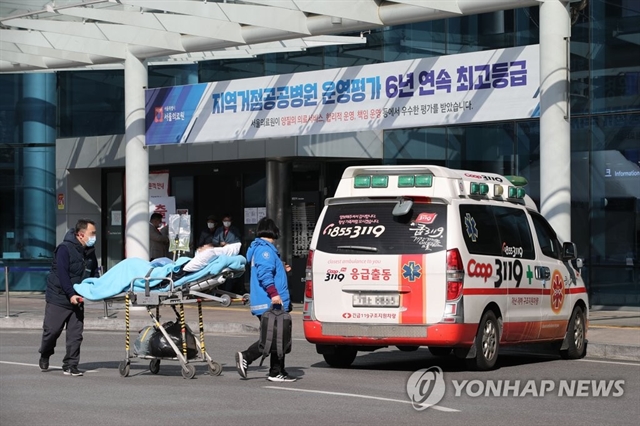 World
World


|
| A patient is moved from Seoul Medical Centre in Seoul to another hospital on Thursday after the centre was designated a COVID-19-only hospital. —YONHAP/VNA Photo |
SEOUL — South Korea reported 256 new cases of the coronavirus on Friday, bringing the total number of infections here to 2,022 as the nation aggressively counters the fast-spreading virus with a massive testing regime.
So far, 13 people have died in South Korea from the virus that emerged in China.
South Korea confirmed its first new coronavirus case from a Chinese woman from Wuhan, the epicentre of the virus outbreak, on January 20.
More than half of newly confirmed cases are linked to a branch of a religious sect in the southeastern city of Daegu.
Of the 256 new cases, 182 are in Daegu, 300 kilometres southeast of Seoul, and 49 are in the neighbouring North Gyeongsang Province. The total number of infections in Daegu and North Gyeongsang stands at 1,314 and 394, respectively.
Other major provinces and cities have also reported some infections, with Seoul reporting another six cases, the Korea Centres for Disease Control and Prevention (KCDC) said in a statement.
Daejeon and Busan counted four and two new cases, respectively, while Gyeonggi and South Gyeongsang provinces reported four and three more, respectively.
Since raising the virus alert level to "red," the highest level, on Sunday, health authorities have focused on halting the spread of the virus in Daegu, the epicentre of the virus outbreak here, and North Gyeongsang Province.
Experts said the number of confirmed cases is expected to jump in the coming days as health authorities have begun testing more than 210,000 members of the Shincheonji Church of Jesus at the centre of the rapid spread in other provinces.
Since the first outbreak on January 20 in South Korea, the pace of infections had not been alarming until February 18, when a 61-year-old woman who is tied to the Daegu religious sect tested positive for the virus.
Since then, the nation has seen an explosion in infections as it accelerated virus tests on potential cases.
South Korea has released 26 fully recovered novel coronavirus patients from hospitals as of Friday morning, the KCDC said.
The number of people being checked for the virus and under quarantine came to 24,751, it added. The country has tested a total of 68,918 suspected cases, with 44,167 testing negative.
In a related movement, South Korean health authorities said on Friday they are making utmost efforts to maximise efficiency in treating novel coronavirus patients amid a spike in new confirmed cases in the country's southeastern areas.
Out of confirmed 1,017 COVID-19 patients in the southeastern city of Daegu, only 447 have been admitted to hospitals and another 570 are awaiting beds in hospitals while in self-quarantine at their homes as of early Thursday, according to city government officials.
Daegu - South Korea's fourth-largest city, with a population of 2.4 million - has emerged as a hotbed of coronavirus outbreaks in South Korea, along with neighbouring North Gyeongsang Province.
Concerns over a possible shortage of hospital beds in the hardest-hit region escalated after a 75-year-old virus patient who is tied to a religious sect in Daegu died of respiratory failure earlier Thursday, bringing the nation's death toll to 13.
The patient, despite having underlying diseases, was in self-quarantine at his home when he died while awaiting to be admitted to a local hospital.
"It is our principle to designate critical COVID-19 patients to hospitals that can provide intensive-care treatment," said Jeong Eun-kyeong, head of the Korea Centres for Disease Control and Prevention.
The KCDC said it has provided guidelines so that doctors can swiftly allocate hospital beds to patients in accordance with the severity of the disease and move serious patients to negative-pressure isolation wards.— YONHAP




